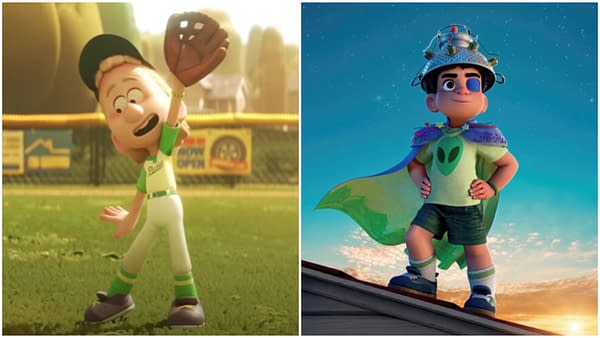Posted in: Disney+, Movies, Opinion, TV, TV | Tagged: disney, opinion, pixar
Pixar’s series Win or Lose and film Elio have one frustrating thing in common. Does the animation studio suddenly have a Disney problem?
▶” style=”border: 0px;” allow=”accelerometer; autoplay; encrypted-media; gyroscope; picture-in-picture; fullscreen;” loading=”lazy” src=”https://www.youtube.com/embed/AhxGObicnPs?feature=oembed” title=”Youtube Video”>
We can all agree that Disney and Pixar have had a pretty impressive relationship (to say the least) since “The Mouse” finalized a deal to acquire the animation studio in 2006: the “Cars” franchise, Ratatouille, WALL-E, Up, the “Toy Story” franchise, Coco, Monsters University, the “Inside Out” franchise, and many other films. On the television side, we’ve seen Car Toons, Monsters at Work, Inside Pixar, and additional series and shorts.
And then 2025 happened. With Disney+’s Win or Lose serving as Pixar’s first original animated series, expectations were high, and the critical responses were strong. Yet, the series would generate more headlines from the controversy surrounding it than it did during its streaming run. And then there’s the feature film Elio, which currently sits “Certified Fresh” with critics and “Verified Hot” with audiences on Rotten Tomatoes – but also owns the “honor” of having the lower domestic box office opening of any film in Pixar’s history (with $20.8 million).
So what happened? While any number of factors could come into play, we can’t overlook one thing that both the Disney+ series and feature film have in common. In each instance, someone within Disney and/or Pixar made the call to make some significant creative overhauls to make the project more “family-friendly. ” This resulted in character-related LGBTQ issues and themes being scrubbed from the show and film. Here’s a look at some of the backstory on both projects:

Disney+’s “Win or Lose”: It was back in December 2024 when the word came down that Disney would be pulling a transgender storyline that was originally included in the animated series. “When it comes to animated content for a younger audience, we recognize that many parents would prefer to discuss certain subjects with their children on their own terms and timeline,” Disney shared in a statement to The Hollywood Reporter when asked to confirm reports that the creative change was being made to the animated series.
“Oh my God, it was crazy. I wore it as a badge. I wore it with pride. I wore it with honor because it meant so much to me. The thought of authentically portraying a transgender teenage girl made me really happy. I wanted to make this for transgender kids like me.” That was how 14-year-old actress Chanel Stewart felt when she learned that she had been picked to voice a transgender teenager in the animated series. That would change dramatically when Chanel and her mother, Keisha, were informed that the animated series’ transgender storyline had been pulled. Though Stewart’s character remained in the Pixar project, several lines of dialogue referencing gender identity were edited out. “It’s just that my character would now be a cis girl, a straight cis girl. So yeah, that’s all they really told me and that I was still a part of the show,” the now actress shared.
“It was upsetting because my daughter is transgender, and this is her life. I felt like it was very important that we not hide that fact,” Keisha shared exclusively with Deadline Hollywood. “There may be some parents out there who are not ready to have that conversation, but this is the world that we live in, and everyone should be represented. Everyone deserves to be recognized. And it felt like it was just another setback for the LGBTQ community because it’s very hard on transgender teenagers … transgender people, period. Especially when you’re young and you’re trying to figure out how to navigate this world that you live in and be able to grow into your own person.”
“I was very disheartened. From the moment I got the script, I was excited to share my journey to help empower other trans youth. I knew this would be a very important conversation. Trans stories matter, and they deserve to be heard,’ Stewart added, adding that there was one thing that Disney definitely couldn’t take away from her. “I’m definitely one of the first [transgender girls] to do this! It’s a true honor to be a part of queer history.”
In April 2025, Pixar animator Danny Barnhart shared on Instagram an early version of a moment that spotlighted trans-character Kai. In addition, Barnhart walked fans through “the monumental amount of care and skill that went in to developing Kai, every department from casting to story to animation to shading to lighting, and everything outside and in between, handled her with a reverence and kindness that I wish I could hand deliver to every trans person who needs it right now.” Here’s a look at Barnhart’s post:
Happy Trans Day of Visibility 🏳️⚧️✨ I’m one of the trans artists who worked on Win or Lose, and I’m gonna talk about it 👍
This is a small snippet of the monumental amount of care and skill that went in to developing Kai, every department from casting to story to animation to shading to lighting, and everything outside and in between, handled her with a reverence and kindness that I wish I could hand deliver to every trans person who needs it right now.
1. As many audience members have guessed, Kai’s conversation with her dad at the head of her episode was never about baseball, it was her coming out 🏳️⚧️
2. We explored representing Kai’s dysphoria as if it abstracted her face into fractured pieces. We aimed to represent what Kai was experiencing inside, rather than create an antagonist creature like we did with Sweaty and Laurie.
3. We wanted to translate the puzzle pieces to 3D forms, while also trying to avoid anything that would make her look ‘scary’ or monstrous – we never wanted to take away her humanity.
4. As we explored these visuals, we realized that making the abstract forms look and feel similar to Kai’s body made the experience feel too external (and a little creepy), and it would greatly impact how we would have to animate her face. For these reasons, we branched away from the physical puzzle face effect. It was a really cool visual experiment, though!
5. We returned to 2D for Kai’s dysphoria, and additionally developed the sinking and scratches to express Kai’s pain without distorting her physical form.
6. While we loved the visuals we created for when Kai is feeling down, it was important to us to establish a positive foil to avoid implying that the trans experience is an exclusively negative one. For this reason, we set out to capture trans joy. Kai floats when she feels affirmed, and is surrounded by joyful colors and light.
7. When Kai meets the Pickles, it was the first time she used her chosen name, and we learn Hannah is nonbinary 🏳️⚧️
▶” style=”border: 0px;” allow=”accelerometer; autoplay; encrypted-media; gyroscope; picture-in-picture; fullscreen;” loading=”lazy” src=”https://www.youtube.com/embed/is2meozrnx0?feature=oembed” title=”Youtube Video”>
Pixar’s “Elio”: Less than two weeks after the film’s dismal box office debut, industry insiders are still trying to connect the dots on what went wrong. In a piece published by The Hollywood Reporter early today, a number of folks involved with the production shared (both on and off the record) that the film was well-received initially in 2023. Reportedly, the lead character was initially portrayed as “a queer-coded character,” though some who spoke with THR added that director Adrian Molina (Coco) “did not intend the film to be a coming out story, as the character is 11.” Whatever the original intentions were, they would reportedly no longer be a factor after a 2023 test screening.
According to a source with knowledge of the test screenings, attendees expressed their enjoyment of the film – but then, the other shoe dropped. When asked if they would go see the movie in the theater, reportedly no one in the test screening raised their hand. Adding more fuel to the executives’ concerns was a screening that Molina held around that same time for the heads of Pixar. According to THR’s report, “There are differing accounts of the exact feedback that the director received from Pixar boss Pete Docter when the lights went up, with rumors circulating in some of the studio’s circles that Molina was hurt by the conversation.”
Shortly after, Molina would depart the animated film, with co-directors Madeline Sharafian and Domee Shi brought aboard for what would be a retooled story. To reportedly make Elio more masculine, certain scenes (like Elio’s “trash-ion show” and the pictures on display in his room implying that he had a male crush) were scaled back and some of Elio’s interests (like fashion and the environment) that were believed to be too “coded” were left off the screen.
In trying to make too many people happy, did Disney and Pixar end up making no one happy? Is “The Mouse” trying to win over folks who will never see Disney as anything but “woke”? Maybe it’s time to let Pixar be Pixar again, and let the animation studio go back to telling amazing stories without having to constantly look over its metaphorical shoulder out of fear of hate mongers who won’t be happy until we go back to having nothing but straight, white lead characters.
Stay up-to-date and support the site by following Bleeding Cool on Google News today!
